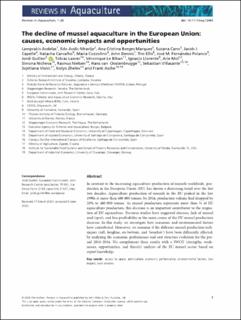| dc.contributor.author | Avdelas, Lamprakis | |
| dc.contributor.author | Avdic-Mravlje, Edo | |
| dc.contributor.author | Borges Marques, Ana Cristina | |
| dc.contributor.author | Cano, Suzana | |
| dc.contributor.author | Capelle, Jacob J. | |
| dc.contributor.author | Carvalho, Natacha | |
| dc.contributor.author | Cozzolino, Maria | |
| dc.contributor.author | Dennis, John | |
| dc.contributor.author | Ellis, Tim | |
| dc.contributor.author | Fernández Polanco, José M. | |
| dc.contributor.author | Guillen, Jordi | |
| dc.contributor.author | Lasner, Tobias | |
| dc.contributor.author | Le Bihan, Véronique | |
| dc.contributor.author | Llorente, Ignacio | |
| dc.contributor.author | Mol, Arie | |
| dc.contributor.author | Nicheva, Simona | |
| dc.contributor.author | Nielsen, Rasmus | |
| dc.contributor.author | van Oostenbrugge, Hans | |
| dc.contributor.author | Villasante, Sebastian | |
| dc.contributor.author | Visnic, Svjetlana | |
| dc.contributor.author | Zhelev, Kolyo | |
| dc.contributor.author | Asche, Frank | |
| dc.date.accessioned | 2021-03-23T10:29:35Z | |
| dc.date.available | 2021-03-23T10:29:35Z | |
| dc.date.created | 2020-09-02T16:32:24Z | |
| dc.date.issued | 2021-01 | |
| dc.identifier.citation | Avdelas, L., Avdic‐Mravlje, E., Borges Marques, A.C. et al. (2021) The decline of mussel aquaculture in the European Union: causes, economic impacts and opportunities. Reviews in Aquaculture, 13(1), 1-28. | en_US |
| dc.identifier.issn | 1753-5123 | |
| dc.identifier.uri | https://hdl.handle.net/11250/2735024 | |
| dc.description.abstract | In contrast to the increasing aquaculture production of mussels worldwide, production in the European Union (EU) has shown a decreasing trend over the last two decades. Aquaculture production of mussels in the EU peaked in the late 1990s at more than 600 000 tonnes; by 2016, production volume had dropped by 20% to 480 000 tonnes. As mussel production represents more than ⅓ of EU aquaculture production, this decrease is an important contributor to the stagnation of EU aquaculture. Previous studies have suggested diseases, lack of mussel seed (spat), and low profitability as the main causes of the EU mussel production decrease. In this study, we investigate how economic and environmental factors have contributed. Moreover, we examine if the different mussel production techniques (raft, longline, on‐bottom, and ‘bouchot’) have been differently affected, by analysing the economic performance and cost structure evolution for the period 2010–2016. We complement these results with a SWOT (strengths, weaknesses, opportunities, and threats) analysis of the EU mussel sector based on expert knowledge. | en_US |
| dc.language.iso | eng | en_US |
| dc.publisher | John Wiley & Sons Ltd. | en_US |
| dc.rights | Navngivelse 4.0 Internasjonal | * |
| dc.rights.uri | http://creativecommons.org/licenses/by/4.0/deed.no | * |
| dc.subject | muslinger | en_US |
| dc.subject | EU | en_US |
| dc.subject | produksjonstap | en_US |
| dc.title | The decline of mussel aquaculture in the European Union: causes, economic impacts and opportunities | en_US |
| dc.type | Peer reviewed | en_US |
| dc.type | Journal article | en_US |
| dc.description.version | publishedVersion | en_US |
| dc.rights.holder | © 2020 The Authors. | en_US |
| dc.subject.nsi | VDP::Landbruks- og Fiskerifag: 900::Fiskerifag: 920::Akvakultur: 922 | en_US |
| dc.subject.nsi | VDP::Samfunnsvitenskap: 200::Økonomi: 210 | en_US |
| dc.source.pagenumber | 1-28 | en_US |
| dc.source.volume | 13 | en_US |
| dc.source.journal | Reviews in Aquaculture | en_US |
| dc.source.issue | 1 | en_US |
| dc.identifier.doi | 10.1111/raq.12465 | |
| dc.identifier.cristin | 1826871 | |
| cristin.ispublished | true | |
| cristin.fulltext | original | |
| cristin.qualitycode | 1 | |

